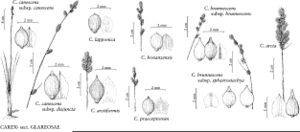Carex arcta
Ill. Carex, 155, plate 497. 1867.
Plants densely cespitose; rhizomes short. Culms erect, slender, 15–80 cm, very rough distally. Leaves: sheaths pale to graybrown abaxially, inner band thin, hyaline, conspicuously purplish dotted, concave at summit; ligules acute, longer than wide; blades pale to gray-green, flat, 15–50 cm × 2–4 mm, shorter than to exceeding culms. Inflorescences erect, ovoid-oblong, 1.5–4 cm × 7–12 mm; proximal bracts (sometimes also 2d) bristlelike-prolonged, from short to clearly exceeding spikes, distal bracts usually scalelike. Spikes 5–15, gynecandrous, proximal often slightly separate, distal closely approximate (sometimes hardly recognizable), containing 10–20 perigynia, sessile, oblong, 5–10 × 4–6 mm. Pistillate scales hyaline with green center, often brown tinged, ovate, shorter than perigynia, apex obtuse to short-cuspidate. Perigynia spreadingascending, greenish, often brown in age, several-veined, ovate, widest near base, 2–3 (–3.5) × 1.25–1.5 mm, minutely papillose (membranous); beak abaxial suture conspicuous, 0.75–1.25 mm, margin serrulate. Achenes pale-brown, ovate, 1.25–1.5 1 mm, dull to slightly glossy. 2n = 60.
Phenology: Fruiting Jun–Sep.
Habitat: Swampy (coniferous) woods and thickets, wet meadows
Elevation: 0–2000 m
Distribution

Alta., B.C., Man., N.B., Ont., Que., Yukon, Calif., Idaho, Maine, Mass., Mich., Minn., Mont., N.H., N.Y., Oreg., Vt., Wash., Wis.
Discussion
Selected References
None.
Lower Taxa
"shortened" is not a number."widest" is not a number."bristlelike-prolonged" is not a number.
